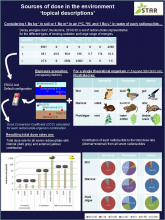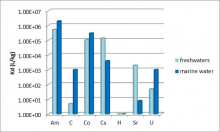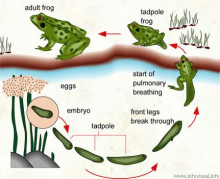Sources of environmental dose
Complementary to factsheets which will summarise the radioecological information element by element, two ‘topical descriptions’ will show absorbed doses estimations, for wildlife species and for typical environmental exposure scenarios. The objective is to allow a non‐specialist audience to understand the link between environmental contamination with radionuclides (Bq) and the doses (absorbed, equivalent or effective) to wildlife species. These examples will illustrate some of the factors that affect the estimation of the dose to a target organism: types of radionuclides, internal and external doses, exposure pathways and diet, life stages and lifecycle.
Scenario 1: Relative importance of internal vs. external dose and exposure routes when exposed radionuclides in the environment Fauna and flora live in different generic ecosystems (freshwater, marine or terrestrial). This leads to a huge biodiversity, associated with a large range of sizes and behaviours all of which may impact on doses potentially absorbed by organisms from exposure to ionizing radiation. In order to illustratively compare potential doses characteristic of these ecosystems for 3 groups of ubiquitous organisms (mammals, plants and birds), excluding the purely geometric effect of their size, a simple dose assessment was conducted, with the following basic assumptions:
Using the ERICA Tool default data for the 3 organism groups, total dose rates for the seven selected radionuclides were calculated for each organism in each ecosystem, differentiating internal and external contribution. The contribution of each radionuclide to the total dose rate is also shown. The highest dose rates are estimated to be received in freshwater and marine ecosystems, partly due to exposure to sediment. Consistently, plants in these two ecosystems are more exposed than other organisms, due to their exposure scenario (100% at the sediment surface). This is also the reason why external dose rates are higher than internal ones for this group. Small differences are observed between freshwater and marine organisms, due to generally higher transfer parameter values in the marine environment, both in terms of the sediment-water distribution coefficient (or Kd) and concentration ratio (Figure 1). The larger discrepancy observed between aquatic and terrestrial organisms is largely explained by commonly lower concentration ratios defined for terrestrial ecosystems.
Figure 1: comparative values of transfer parameters in the three ecosystems, for the different radionuclide-organism combinations (on the left: Kd; on the right: concentration ratios). For terrestrial organisms, the main contributor is 14C, according to its concentration ratios, at least one order of magnitude higher than the others (though 14C concentrations are predicted from air whereas the other radionuclides considered are predicted from soil concentrations). In freshwaters, depending on the organism, 238U (bird), 137Cs (mammal) and 241Am (plant) contribute most to the organisms exposure. Marine fauna exposure results primarily from 241Am although 60Co contributes more than 75% of dose rate to marine algae. In aquatic ecosystems, the dominance of a radionuclide is due to a combination of factors including the exposure scenario and transfer parameter values. |
Scenario 2: Radiation doses to frogs during different life stages Exposure pathways of radiation and the resulting doses may differ for different life stages in an animals life cycle. A frog’s life cycle is complex and encompasses several habitats and physiological changes. The first egg life stages are aquatic and laid in shallow freshwater. After hatching the tadpole is a free swimming herbivore breathing through gills. During metamorphosis the tadpole changes into a lung respiring juvenile carnivorus frog and migrate to terrestrial habitat. The adult frog will live in terrestrial or wetland habitat and return to freshwaters to breed. In temperate climates it will hibernate during the winter months in soil under logs or stones and in stream sediment. In this radiation dose calculation example seven radionuclides (137Cs, 241Am, 14C, 60Co, 3H, 90Sr, 238U) and five scenarios for different life stages of a frog were chosen:
The ERICA Tool was used and activity concentrations of 137Cs in soil or sediment was assumed to be 1 Bq kg-1. |




